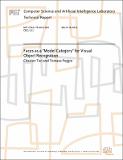Faces as a "Model Category" for Visual Object Recognition
Author(s)
Tan, Cheston; Poggio, Tomaso
DownloadMIT-CSAIL-TR-2013-004.pdf (227.9Kb)
Other Contributors
Center for Biological and Computational Learning (CBCL)
Advisor
Tomaso Poggio
Metadata
Show full item recordAbstract
Visual recognition is an important ability that is central to many everyday tasks such as reading, navigation and social interaction, and is therefore actively studied in neuroscience, cognitive psychology and artificial intelligence. There exist thousands of object categories, all of which pose similar challenges to biological and artificial visual systems: accurate recognition under varying location, scale, view angle, illumination and clutter. In many areas of science, important discoveries have been made using "model organisms" such as fruit flies, mice and macaques. For the thousands of object categories, the important and well-studied category of faces could potentially serve as a "model category" upon which efforts are focused, and from which fundamental insights are drawn. However, it has been hotly debated whether faces are processed by the brain in a manner fundamentally different from other categories. Here we show that "neural tuning size" -- a single parameter in a computational model of object processing -- is able to account for important face-specific phenomena. Thus, surprisingly, "face-like" processing is explainable by physiological mechanisms that differ only quantitatively from "object-like" processing. Our computational proof-of-principle provides specific neural tuning properties that correspond to the so-far qualitative and controversial notion of "holistic" face processing. Overall, faces may be a viable model category. Since faces are highly amenable to complementary experimental techniques like functional MRI, electrophysiology, electroencephalography and transcranial magnetic stimulation, this further raises the odds that the algorithms and neural circuits underlying visual recognition may first be solved for faces. With faces serving as a model category, the great scientific challenge of understanding and reverse-engineering general visual recognition can be greatly accelerated.
Date issued
2013-03-18Series/Report no.
MIT-CSAIL-TR-2013-004CBCL-311
Keywords
face recognition, object recognition, holistic processing, composite effect, inversion effect